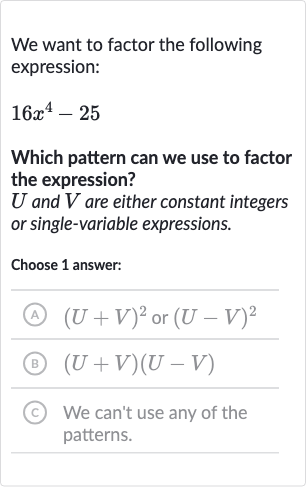AI tutor
Welcome to Bytelearn!
Let’s check out your problem:

We want to factor the following expression:Which pattern can we use to factor the expression? and are either constant integers or single-variable expressions.Choose answer:(A) or (B) (C) We can't use any of the patterns.
Full solution
Q. We want to factor the following expression:Which pattern can we use to factor the expression? and are either constant integers or single-variable expressions.Choose answer:(A) or (B) (C) We can't use any of the patterns.
- Recognize the form: Recognize the form of the expression.The expression is a difference of squares because it can be written as .
- Apply difference of squares: Apply the difference of squares pattern.The difference of squares pattern is , where and are any expressions.
- Identify U and V: Identify U and V in the expression.In the expression , U is and V is .
- Factor using difference of squares: Factor the expression using the difference of squares pattern.Using the pattern , we get .
- Check the factored expression: Check the factored expression. when multiplied out should give us the original expression ., which is the original expression.
More problems from Compare linear and exponential growth
QuestionGet tutor help
QuestionGet tutor help
QuestionGet tutor help
QuestionGet tutor help
QuestionGet tutor help
QuestionGet tutor help
QuestionGet tutor help
QuestionGet tutor help
QuestionGet tutor help
